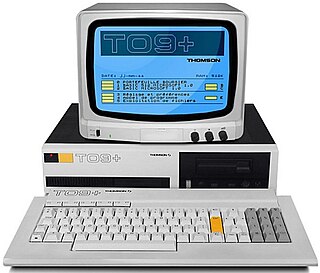
Video Graphics Array (VGA) is a video display controller and accompanying de facto graphics standard, first introduced with the IBM PS/2 line of computers in 1987, which became ubiquitous in the IBM PC compatible industry within three years. The term can now refer to the computer display standard, the 15-pin D-subminiature VGA connector, or the 640 × 480 resolution characteristic of the VGA hardware.
Amiga Advanced Graphics Architecture (AGA) is the third-generation Amiga graphic chipset, first used in the Amiga 4000 in 1992. Before release AGA was codenamed Pandora by Commodore International.
MSX BASIC is a dialect of the BASIC programming language. It is an extended version of Microsoft's MBASIC Version 4.5, adding support for graphic, music, and various peripherals attached to MSX microcomputers. Generally, MSX BASIC is designed to follow GW-BASIC, released the same year for IBM PCs and clones. During the creation of MSX BASIC, effort was made to make the system flexible and expandable.

The X68000 is a home computer created by Sharp Corporation. It was first released in 1987 and sold only in Japan.

The 8563 Video Display Controller (VDC) was an integrated circuit produced by MOS Technology. It was used in the Commodore 128 (C128) computer to generate an 80-column RGB video display, running alongside a VIC-II which supported Commodore 64-compatible graphics. The DCR models of the C128 used the later and more technically advanced 8568 [D]VDC controller.

The ThomsonMO5 is a home computer introduced in France in June 1984 to compete against systems such as the ZX Spectrum and Commodore 64. It had a release price of 2390 FF.

The Yamaha V9938 is a video display processor (VDP) used on the MSX2 home computer, as well as on the Geneve 9640 enhanced TI-99/4A clone and the Tatung Einstein 256. It was also used in a few MSX1 computers, in a configuration with 16kB VRAM.
The G364 framebuffer was a line of graphics adapters using the SGS Thomson INMOS G364 colour video controller, produced by INMOS in the early 1990s. The G364 included a RAMDAC and a 64-bit interface to VRAM graphical memory to implement a framebuffer, but did not include any hardware-based graphical acceleration other than a hardware cursor function.

The MOS Technology 8568 Video Display Controller (VDC) was the graphics processor responsible for the 80-column or RGBI display on the Commodore 128DCR personal computer. In the Commodore 128 service manual, this component was referred to as the "80 column CRT controller. The 8568 incorporated many of the features of the older 6545E monochrome CRT controller, with the addition of RGBI color.

A video display controller (VDC), also called a display engine or display interface, is an integrated circuit which is the main component in a video-signal generator, a device responsible for the production of a TV video signal in a computing or game system. Some VDCs also generate an audio signal, but that is not their main function. VDCs were used in the home computers of the 1980s and also in some early video picture systems.
Hombre is a RISC chipset for the Amiga, designed by Commodore, which was intended as the basis of a range of Amiga personal computers and multimedia products, including a successor to the Amiga 1200, a next generation game machine called CD64 and a 3D accelerator PCI card. Hombre was canceled along with the bankruptcy of Commodore International.
The eXtended Graphics Array is a graphics card manufactured by IBM and introduced for the IBM PS/2 line of personal computers in 1990 as a successor to the 8514/A. It supports, among other modes, a display resolution of 1024 × 768 pixels with 256 colors at 43.5 Hz (interlaced), or 640 × 480 at 60 Hz (non-interlaced) with up to 65,536 colors. The XGA-2 added an 800 × 600 65,536 color mode and 1024 × 768 60 Hz non-interlaced.

The ThomsonMO6 was a Motorola 6809E-based computer introduced in France in 1986. It was intended as the successor to the Thomson MO5 and featured 128 KB of RAM, a 40 × 25 text display, and a new built-in Microsoft BASIC interpreter. It retained compatibility with its predecessor, while incorporating the same technology as the TO8.

Text-based semigraphics, pseudographics, or character graphics is a primitive method used in early text mode video hardware to emulate raster graphics without having to implement the logic for such a display mode.

The PlayStation technical specifications describe the various components of the original PlayStation video game console.

The Thomson TO8 is a home computer introduced by French company Thomson SA in 1986, with a cost of 2,990 FF. It replaces its predecessor, the Thomson TO7/70, while remaining essentially compatible.
BASIC 1.0 is the standard BASIC language for Thomson computers, which is the reference for the entire range. This is an implementation of Microsoft BASIC (BASIC-69). It was used to introduce children from France to programming in the 1980s. Three languages were mainly taught: LSE, BASIC and LOGO. School textbooks programs were given in BASIC 1.0 for Thomson and sometimes in ExelBasic for the Exelvision EXL 100.

The Thomson TO9+ is a home computer introduced by French company Thomson SA in 1986. It kept the professional look of the Thomson TO9 by using a separate keyboard.

The EF9345 from SGS-Thomson Microelectronics, Inc., was a semigraphic single chip microprocessor for video image control, encapsulated in a 40-pin DIP and used primarily in the Matra Alice 32, Matra Alice 90 and Philips VG5000 microcomputers. It was also the video processor of the Minitel 1b terminals, built by either Alcatel and Philips at more than 2 million of units.















